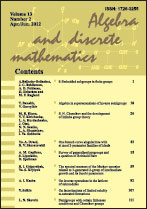|
|
Algebra and Discrete Mathematics, 2005, Issue 1, Pages 133–150
(Mi adm295)
|
 |
|
 |
This article is cited in 3 scientific papers (total in 3 papers)
RESEARCH ARTICLE
Maximality of affine group, and hidden graph cryptosystems
Vasiliy A. Ustimenko
Kiev Mohyla Academy (Ukraine)
Abstract:
We describe a new algebraic-combinatorial method of public key encryption with a certain similarity to the well known Imai–Matsumoto. We use the general idea to treat vertices of a linguistic graph (see [21] and further references) as messages and use the iterative process to walk on such graph as encryption process. To hide such encryption (graph and walk on it) we will use two affine transformation. Like in Imai–Matsumoto encryption the public rule is just a direct polynomial map from the plaintext to the ciphertext.
The knowledge about graph and chosen walk on them (the key) allow to decrypt a ciphertext fast. We hope that the system is secure even in the case when the graph is Public but the walk is hidden. In case of “public” graph we can use same encryption as private key algorithm with the resistance to attacks when adversary knows several pairs:(plaintext, ciphertext).
We shall discuss the general idea of combining affine transformations and chosen polynomial map of ${\rm deg}\ge 2$ in case of prime field $F_p$. As it follows from the maximality of affine group each bijection on ${F_p}^n$ can be obtained by such combining.
Keywords:
Data and communication security, e-commerce, Public Key Cryptography, Private Key Encryption.
Received: 22.02.2004
Revised: 21.03.2005
Citation:
Vasiliy A. Ustimenko, “Maximality of affine group, and hidden graph cryptosystems”, Algebra Discrete Math., 2005, no. 1, 133–150
Linking options:
https://www.mathnet.ru/eng/adm295 https://www.mathnet.ru/eng/adm/y2005/i1/p133
|

|




 Contact us:
Contact us: Terms of Use
Terms of Use
 Registration to the website
Registration to the website Logotypes
Logotypes








 Citation in format
Citation in format 
